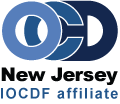Dr. John Piacentini, Ph.D., ABPP Presented on”Cognitive Behavioral Therapy for OCD: How Science is Making Effective Treatment Even Better”
by Rachel Strohl, Psy.D.
 On Sunday March 13, 2016, John Piacentini, PhD, ABPP. presented at the annual conference of OCD New Jersey (OCD NJ). Dr. Piacentini is Professor of Psychiatry and Director of the UCLA Child OCD, Anxiety and Tic Disorders Program and Center for Child Anxiety, Resilience, Education and Support (CARES). Dr. Piacentini’s research focuses on the development and testing of evidence-based treatments for child OCD, anxiety, tics, trichotillomania and related disorders. He has written over 200 scientific papers and book chapters, including four books. He serves on Scientific/ Clinical Advisory Boards for the IOCDF, Anxiety and Depression Association of American (ADAA) and the Trichotillomania Learning Center (TLC), and is Chair of the Tourette Syndrome Association Behavioral Sciences Consortium. Dr. Piacentini has lectured to scientists, clinicians, and patients/families all over the world and has trained hundreds of clinicians in the use of cognitive behavior therapy for OCD and related disorders.
On Sunday March 13, 2016, John Piacentini, PhD, ABPP. presented at the annual conference of OCD New Jersey (OCD NJ). Dr. Piacentini is Professor of Psychiatry and Director of the UCLA Child OCD, Anxiety and Tic Disorders Program and Center for Child Anxiety, Resilience, Education and Support (CARES). Dr. Piacentini’s research focuses on the development and testing of evidence-based treatments for child OCD, anxiety, tics, trichotillomania and related disorders. He has written over 200 scientific papers and book chapters, including four books. He serves on Scientific/ Clinical Advisory Boards for the IOCDF, Anxiety and Depression Association of American (ADAA) and the Trichotillomania Learning Center (TLC), and is Chair of the Tourette Syndrome Association Behavioral Sciences Consortium. Dr. Piacentini has lectured to scientists, clinicians, and patients/families all over the world and has trained hundreds of clinicians in the use of cognitive behavior therapy for OCD and related disorders.
Dr. Piacentini began his talk with evidence that supports the efficacy of treating OCD and anxiety disorders with 1) psychosocial interventions, such as cognitive behavioral treatment (CBT), 2) pharmacologic interventions, such as SSRIs, and 3) combined approaches. He cited several important studies including the Pediatric OCD Treatment Study (POTS, 2004), UCLA CBT for Child OCD Study (2011), and Child/ Adolescent Anxiety Multimodal Treatment Study (CAMS, 2010). Some of the clinical implications are CBT and medication both lead to improvement, combined treatment offers additional benefit for anxiety and possibly OCD, and response rates are higher than remission rates. The research highlights that evidence-based psychotherapy for anxiety/ OCD can provide significant symptom reduction to a majority of patients, provide significant symptom relief to a minority of patients, and long-term relief to about half of the patients.
Dr. Piacentini discussed how to enhance treatment by targeting three key areas: 1) Engagement phase: the research found that higher treatment expectations led to treatment working better. Positive expectations can be enhanced by effective psychoeducation with focus on treatment model and course (e.g., the OCD compulsive cycle), and early efforts instill a sense of trust and efficacy in therapist.
2) Intervention phase: a) a positive therapeutic relationship, reported by the youth, predicted better outcome (CAMS, 2010). According to Chu (2015) and Craske et al. (2008), youth coping in session did not predict better outcome, therapist who pushed exposure predicted better outcome, and sustained exposures led to acute increase in anxiety but better overall outcome.
b) Exposure is the key ingredient in CBT for OCD and anxiety. Habituation, or corrective learning requires activation of fear, followed by gradual reduction in distress that results from repeated exposures to the feared stimulus in the absence of the ritual or avoidance. Craske et al. (2008) found stopping exposures when anxiety is elevated can lead to good outcomes, and increased exposure adrenaline release may enhance exposure efficacy. This suggests an increased focus on “fear tolerance” rather than “fear reduction” during exposure.
c) Cognitive interventions include externalizing (recognize and relabel fears as OCD), reality testing, and learning to tolerate uncertainty. Coping thoughts may distract patients from exposure tasks; instead, affect labeling may be a better option (“I feel frightened right now”). Imaginal exposure to emphasize the focus on catastrophic outcome may be helpful during in vivo exposures.
d) Mindfulness is being in the present moment, with awareness, without judgment in the present moment rather than thinking about the past or future. Mindfulness during exposures is different than using relaxation and has some evidence to support efficacy.
Dr. Piacentini also discussed e) cognitive bias modification and f) biological targets. The latter found that augmenting CBT with glutamatergic modulators (e.g., D-cycloserine, N-acetyl-cysteine) to reduce high glutamate levels may improve CBT outcomes.3) Family environment targets several goals of family intervention, including decreasing levels of conflict and feeling blame and anger, enhancing family problem solving, and facilitating disengagement. In the UCLA Child OCD CBT Study (2012), there was a worse treatment response associated with higher parental blame, greater family conflict, and lower family cohesion.
Dr. Piacentini concluded his informative talk by stating “existing treatments work well, but not well enough.” The science of psychology is still in the early phases of understanding the factors predicting optimal treatment response and remission.
Our “Living with OCD Panel”
The conference continued with an emotional highlight: the Living with OCD panel moderated by Dr. Weg. The panel consisted of a middle aged, male high school English teacher who has obsessions about being gay and going crazy. He discussed stressful triggers in his life led him to use drugs, but he’s proud of his current sobriety. He found CBT after 20 years of OCD symptoms, and now he “knows how to respond to OCD, not react.”
A female in her 50s working in software sales reported around age 30, she began obsessing about organization and ritualizing for hours by folding her children’s baby clothes in the basement. Her rituals evolved over time to looking up words “for way too much time,” and now she uses delay or doesn’t look up the words at all.A 15 year old boy who started ritualizing four years ago by shutting things over and over. “I couldn’t stop washing my hands because they felt sticky,” but because of ERP, he has reduced his soap squirts from 12 to two. He said, “I make myself better by making things worse. I’m still working, but if I can get better, so can you.”
A 22 year old female graduate student who feels that she’s had OCD her whole life. She recalls obsessive fears about imperfections, fears about people she loved dying, and fears of contaminated germs. She remembers her OCD symptoms got much worse sophomore year of college, and her rituals included “avoiding clothes contaminated by memory,” and avoiding her cell phone out of “paranoia.” She feels the combination of CBT and medication helped her “quiet it all down.”
A 33 year old female media specialist said she has had emetophobia (fear of vomit) since age six, her first time vomiting. She recalled difficulty going and staying in school for many years, and avoided many things, such as sleepovers with friends, dating, and the ability to eat food out of the house and restricted eating in the house. She reported proudly that she finally “met CBT and exposure a year ago and feels more in control of my life.”Each shared their valiant experiences living with OCD, and then audience members asked the panel questions about various topics. As in previous years, the panel members encouraged, educated, and offered hope to the individuals with OCD, their loved ones, and the professionals that treat them.
 Dr. Rachel Strohl is a licensed psychologist at Stress and Anxiety Services of NJ in East Brunswick. She is on the Board of Directors at OCD New Jersey. She may be reached at 732-390-6694.
Dr. Rachel Strohl is a licensed psychologist at Stress and Anxiety Services of NJ in East Brunswick. She is on the Board of Directors at OCD New Jersey. She may be reached at 732-390-6694.
Photo Montage from the Conference

Drs. Rachel Strohl, Allen Weg, John Piacentini, Rob Zambrano, & Marla Deibler

Staff members of Stress & Anxiety Services of New Jersey and The Center for Emotional Health of Greater Philadelphia

Nikki Torella, OCD New Jersey Board Member and Head of Conference Registration, at the DVD sales desk

The Living with OCD Panel: L to R- Luke, Debbie, Chris, Samantha, & Emily
